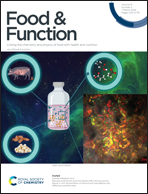Postprandial lipid and vascular responses following consumption of a commercially-relevant interesterified palmitic acid-rich spread in comparison to functionally-equivalent non-interesterified spread and spreadable butter: a randomised controlled trial in healthy adults†
Abstract
Background: Interesterification is an industrial processing technique used widely where hard fats are essential for functionality and consumer acceptability, e.g. margarines and lower fat spreads. Objective: The aim of this study was to compare acute cardiovascular effects of functionally equivalent spreads (similar solid fat content) made with interesterified (IE) or non-IE palm-based fats, or spreadable butter. Methods: A randomised, controlled, 4-armed crossover, double-blind study (25 men, 25 women; 35–75 years; healthy; mean BMI 24.5, SD 3.8), compared effects of mixed nutrient meals containing 50 g fat from functionally equivalent products [IE spread, non-IE spread and spreadable butter (SB), with rapeseed oil (RO) as a reference treatment: with 16.7%, 27.9%, 19.3% and 4% palmitic acid, respectively] on 8 h postprandial changes in plasma triacylglycerol (TAG) and endothelial dysfunction (flow-mediated dilatation; FMD). Circulating reactive oxygen species (estimated using a neutrophil oxidative burst assay), glucose, insulin, NEFA, lipoprotein particle profiles, inflammatory markers (glycoprotein acetylation (Glyc-A) and IL-6), and biomarkers of endotoxemia were measured. Results: Postprandial plasma TAG concentrations after test meals were similar. However following RO versus the 3 spreads, there were significantly higher postprandial apolipoprotein B concentrations, and small HDL and LDL particle concentrations, and lower postprandial extra-large, large, and medium HDL particle concentrations, as well as smaller average HDL and LDL particle sizes. There were no differences following IE compared to the other spreads. Postprandial FMD% did not decrease after high-fat test meals, and there were no differences between treatments. Postprandial serum IL-6 increased similarly after test meals, but RO provoked a greater increase in postprandial concentrations of glycoprotein acetyls (GlycA), as well as 8 h sCD14, an endotoxemia marker. All other postprandial outcomes were not different between treatments. Conclusions: In healthy adults, a commercially-available IE-based spread did not evoke a different postprandial triacylglycerol, lipoprotein subclass, oxidative stress, inflammatory or endotoxemic response to functionally-equivalent, but compositionally-distinct alternative spreads. Clinical trial registry number: NCT03438084 (https://ClinicalTrials.gov).



 Please wait while we load your content...
Please wait while we load your content...